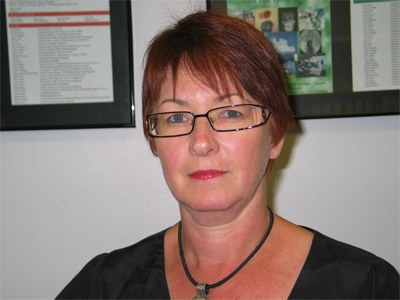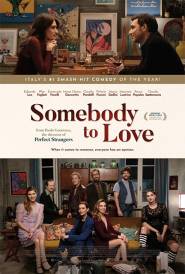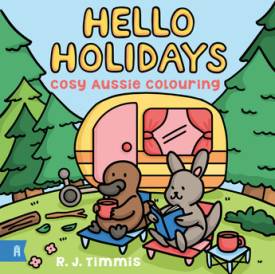Julie Seggie bstreetsmart Interview

Julie Seggie bstreetsmart Interview
18,000 students from across NSW and the ACT will converge on Sydney's Allphones Arena to learn about road safety in a bid to save young lives. The content of the bstreetsmart program (held Tuesday 21st-Thursday 23th August 2012) is confronting for the young drivers.
An initiative of two trauma coordinators at Sydney's Westmead Hospital (Julie Seggie and Stephanie Wilson), bstreetsmart aims to reduce the death toll on our roads by showcasing the dangers of risk-taking behaviour behind the wheel. Students witness a spine-chilling car crash scenario that focuses on in car distraction - in this case, the traumatic consequences of text driving.
'We don't feel that enough is being done to highlight the dangers of text driving,' says Ms Julie Seggie, bstreetsmart organiser and Trauma Clinical Nurse Consultant at Westmead Hospital.
'On our roads you see so many people with one hand on the steering wheel and a mobile phone in the other hand,' continued Julie. 'These drivers are not looking at the roads and are a real hazard not only to themselves but to other drivers and pedestrians.'
'It's not just young drivers who are at risk,' continued Julie. 'While they are often very prolific texters, more experienced drivers also need to be aware that they are modelling bad behaviour to younger drivers when they do this. We simply want more attention paid to the risks of text driving.'
Sydney mother of three, Nola Deck, is an advocate of road safety education after her 29 year old daughter Naomi was seriously injured in a car crash resulting in a traumatic brain injury in 2007. Naomi's crash was not the result of text driving, fortunately, however her crash impacted her life profoundly and the lives of her family.
'All of our lives changed on that day,' said Nola. 'One day we were just ordinary people living our lives when we received the phone call that every parent dreads. Our lives then became centred on brain injury.'
'Children are very perceptive and are learning right from when they are very little. I think it is very important to model good driving behaviours and skills to your children whether they are with you in the car or not,' said Nola.
'You can't be with them every minute of every day but you can instil in them how precious their life is. Encourage them to make wise choices about who they get in a car with and being absolutely sure that they are capable of making good decisions each time they get behind the wheel,' said Nola.
Whilst Nola's daughter Naomi has made a remarkable recovery from her injuries, many others aren't so lucky. Each year nearly 1,300 people are killed in motor vehicle accidents around Australia. 21% of these deaths are of young people aged 17 - 25.
NRMA research results provide evidence that retrieving and, in particular, sending text messages has a detrimental effect on a number of safety-critical driving measures.
According to the NRMA, drivers, when texting, spent up to 400% more time with their eyes off the road than they did when not text messaging. In addition, they did not reduce their speed while distracted, which potentially increases their risk of being involved in a crash because it increases the stopping distance required to avoid a collision.
Open to students in years 10-12, bstreetsmart is organised by Sydney's Westmead Hospital Trauma Unit and is co-funded by The Balnaves Foundation. The program has proven to be so successful that it is now being replicated in both South Australia and Western Australia.
In 2011, Premier Barry O'Farrell committed four years' funding for the important bstreetsmart program with the hope that nearly 50,000 young lives will potentially be saved through road safety education.
For further information, visit www.bstreetsmart.org
For more information read our interview with Shonna Ferris www.girl.com.au/shonna-ferris-bstreetsmart-interview
An initiative of two trauma coordinators at Sydney's Westmead Hospital (Julie Seggie and Stephanie Wilson), bstreetsmart aims to reduce the death toll on our roads by showcasing the dangers of risk-taking behaviour behind the wheel. Students witness a spine-chilling car crash scenario that focuses on in car distraction - in this case, the traumatic consequences of text driving.
'We don't feel that enough is being done to highlight the dangers of text driving,' says Ms Julie Seggie, bstreetsmart organiser and Trauma Clinical Nurse Consultant at Westmead Hospital.
'On our roads you see so many people with one hand on the steering wheel and a mobile phone in the other hand,' continued Julie. 'These drivers are not looking at the roads and are a real hazard not only to themselves but to other drivers and pedestrians.'
'It's not just young drivers who are at risk,' continued Julie. 'While they are often very prolific texters, more experienced drivers also need to be aware that they are modelling bad behaviour to younger drivers when they do this. We simply want more attention paid to the risks of text driving.'
Sydney mother of three, Nola Deck, is an advocate of road safety education after her 29 year old daughter Naomi was seriously injured in a car crash resulting in a traumatic brain injury in 2007. Naomi's crash was not the result of text driving, fortunately, however her crash impacted her life profoundly and the lives of her family.
'All of our lives changed on that day,' said Nola. 'One day we were just ordinary people living our lives when we received the phone call that every parent dreads. Our lives then became centred on brain injury.'
'Children are very perceptive and are learning right from when they are very little. I think it is very important to model good driving behaviours and skills to your children whether they are with you in the car or not,' said Nola.
'You can't be with them every minute of every day but you can instil in them how precious their life is. Encourage them to make wise choices about who they get in a car with and being absolutely sure that they are capable of making good decisions each time they get behind the wheel,' said Nola.
Whilst Nola's daughter Naomi has made a remarkable recovery from her injuries, many others aren't so lucky. Each year nearly 1,300 people are killed in motor vehicle accidents around Australia. 21% of these deaths are of young people aged 17 - 25.
NRMA research results provide evidence that retrieving and, in particular, sending text messages has a detrimental effect on a number of safety-critical driving measures.
According to the NRMA, drivers, when texting, spent up to 400% more time with their eyes off the road than they did when not text messaging. In addition, they did not reduce their speed while distracted, which potentially increases their risk of being involved in a crash because it increases the stopping distance required to avoid a collision.
Open to students in years 10-12, bstreetsmart is organised by Sydney's Westmead Hospital Trauma Unit and is co-funded by The Balnaves Foundation. The program has proven to be so successful that it is now being replicated in both South Australia and Western Australia.
In 2011, Premier Barry O'Farrell committed four years' funding for the important bstreetsmart program with the hope that nearly 50,000 young lives will potentially be saved through road safety education.
For further information, visit www.bstreetsmart.org
For more information read our interview with Shonna Ferris www.girl.com.au/shonna-ferris-bstreetsmart-interview
Interview with Julie Seggie
Question: Why was it important for you begin the bstreetsmart program?
Julie Seggie: Stephanie Wilson and I created the program because there was a group of trauma nurses back in 2004 and we could see that there was a lot of young people coming through the doors, here at the hospital, some were dying an others would never have the life that they had, again. As a group we wanted to do something because it involved all sorts of road accidents, all crashes not just cars and bikes but some were pedestrians who were walking home (doing the right thing) after a night out who still managed to get hit by a car. It caused so much devastation and that is why we wanted to try and do something about it.
Question: What happens during a session of the bstreetsmart program?
Julie Seggie: In the beginning we go through a crash which is stimulated and done in real time (not the crash itself but the rescue) and the video explains what happens if you are in an incident and how the police, ambulance and the rescue team respond including the securing of the car, looking for any dangers and the rescue operation of whoever is involved. Then, what happens once arriving in hospital and the consequences for the driver if they have been doing the wrong thing such as drink driving or whatever the cause.
In the afternoon session the audience can interact with as many interactive displays as they choose to go to which provides a lot of educational material which is hands on and that allows students to do activities such as CPR, First Aid, Stopping distances and all sorts of things; there is also a display of stopping distances.
We also have speakers who have actually had brain injuries, spinal injuries and organ donations as a result.
Question: What is the main message you hope to give students involved in the bstreetsmart program?
Julie Seggie: There are a lot of messages to be had but the main message is that 'you can prevent yourself being injured and prevent others being injured by doing a few simple things'. Issues revolve around distracted drivers whether that is caused by using a mobile phone, texting messaging, drink driving or drugs and driving. We teach the students how to be safe in a car, on a road and to keep others safe as well.
Question: How does the program focus on text-driving?
Julie Seggie: Our program is very multifocal although there is an increasing trend particularly with texting while driving and it is getting worse, especially with the increasing use that young people have in regards to smart phone accessibility - not only can they talk and text they can email, use the GPS, search social networks and browse websites - there are a whole range of things that were never there before. Mobile phones when driving isn't just associated with young people but they certainly don't have the experience to know not to be using the phone whilst driving.
In Australia it is quite sad because everyone knows using a mobile device whilst driving is illegal but we are still doing it and young people just don't realise the consequences so we certainly try and show them what can happen if they are doing it and if they continue to do it they are going to get into trouble at some stage.
Question: Can you talk about the dangers associated with text-driving?
Julie Seggie: If you are sending a text message your eyes come off the road for an estimated five seconds and within that time, if you're on a highway, you can travel the length of a football field! You can spend up to 400% less time looking at the road if you are texting and your risk of a collision goes up 23 times.
The dangers are huge and I know a lot of people out there try and compensate for using their phone by leaving more distance between themselves and the next car but that doesn't help because you have a slower reaction time and your eyes are not on the road.
Question: What incidents have you seen result from text-driving?
Julie Seggie: That is quiet interesting because we certainly know of a percentage and police are investigating that further now, depending on the circumstances of the crash, to know if text-driving has been a factor. People know it's illegal to use their phone whilst driving and know they shouldn't do it so they are very reluctant to say if they had been using their phone before the crash. Unfortunately we don't know the correct figures.
Question: What other risk-taking behaviour does the bstreetsmart program confront in regards to pedestrians?
Julie Seggie: One of the biggest things I find at the moment, that we are getting quiet an increase in, is pedestrians who are wearing headphones to listen to their music or lectures and they're also distracted because they are listening to something quiet intently and they are less aware of what is going on, around them. As a result we are having a lot more pedestrians hit in the younger and the older age group. The younger pedestrian accidents are caused by wearing headphones, more than anything. We are all distracted out there but the headphones are an added element and that is creating a big problem.
Question: What is the number piece of advice you'd give a 18 year old driver?
Julie Seggie: It's important that they have as much information as they can and to turn off their mobile phone before getting into the driver's seat or if you have somebody travelling with you, give them your phone and from then on, while you are driving, you don't go anywhere near your phone. Not drinking and driving is an obvious - you do not drink alcohol if you are going to be driving.
Question: As a trauma coordinator, what does a day on the job involve, for you?
Julie Seggie: Every day is quite different. I see and assist in caring for all the major traumas that come into the hospital and follow their care whilst trying to coordinate it because a trauma patient tends to get injuries that result neurologically as well as broken bones which need orthopaedics and they may have lacerations which need the plastics team; it is a multi-team and we help coordinate all the different teams to get the best care in the quickest time until they go out the door to rehabilitation or home. It's a lot about coordination of care and we also do a huge amount of education for the public, doctors and nurses.
Interview by Brooke Hunter
Julie Seggie: Stephanie Wilson and I created the program because there was a group of trauma nurses back in 2004 and we could see that there was a lot of young people coming through the doors, here at the hospital, some were dying an others would never have the life that they had, again. As a group we wanted to do something because it involved all sorts of road accidents, all crashes not just cars and bikes but some were pedestrians who were walking home (doing the right thing) after a night out who still managed to get hit by a car. It caused so much devastation and that is why we wanted to try and do something about it.
Question: What happens during a session of the bstreetsmart program?
Julie Seggie: In the beginning we go through a crash which is stimulated and done in real time (not the crash itself but the rescue) and the video explains what happens if you are in an incident and how the police, ambulance and the rescue team respond including the securing of the car, looking for any dangers and the rescue operation of whoever is involved. Then, what happens once arriving in hospital and the consequences for the driver if they have been doing the wrong thing such as drink driving or whatever the cause.
In the afternoon session the audience can interact with as many interactive displays as they choose to go to which provides a lot of educational material which is hands on and that allows students to do activities such as CPR, First Aid, Stopping distances and all sorts of things; there is also a display of stopping distances.
We also have speakers who have actually had brain injuries, spinal injuries and organ donations as a result.
Question: What is the main message you hope to give students involved in the bstreetsmart program?
Julie Seggie: There are a lot of messages to be had but the main message is that 'you can prevent yourself being injured and prevent others being injured by doing a few simple things'. Issues revolve around distracted drivers whether that is caused by using a mobile phone, texting messaging, drink driving or drugs and driving. We teach the students how to be safe in a car, on a road and to keep others safe as well.
Question: How does the program focus on text-driving?
Julie Seggie: Our program is very multifocal although there is an increasing trend particularly with texting while driving and it is getting worse, especially with the increasing use that young people have in regards to smart phone accessibility - not only can they talk and text they can email, use the GPS, search social networks and browse websites - there are a whole range of things that were never there before. Mobile phones when driving isn't just associated with young people but they certainly don't have the experience to know not to be using the phone whilst driving.
In Australia it is quite sad because everyone knows using a mobile device whilst driving is illegal but we are still doing it and young people just don't realise the consequences so we certainly try and show them what can happen if they are doing it and if they continue to do it they are going to get into trouble at some stage.
Question: Can you talk about the dangers associated with text-driving?
Julie Seggie: If you are sending a text message your eyes come off the road for an estimated five seconds and within that time, if you're on a highway, you can travel the length of a football field! You can spend up to 400% less time looking at the road if you are texting and your risk of a collision goes up 23 times.
The dangers are huge and I know a lot of people out there try and compensate for using their phone by leaving more distance between themselves and the next car but that doesn't help because you have a slower reaction time and your eyes are not on the road.
Question: What incidents have you seen result from text-driving?
Julie Seggie: That is quiet interesting because we certainly know of a percentage and police are investigating that further now, depending on the circumstances of the crash, to know if text-driving has been a factor. People know it's illegal to use their phone whilst driving and know they shouldn't do it so they are very reluctant to say if they had been using their phone before the crash. Unfortunately we don't know the correct figures.
Question: What other risk-taking behaviour does the bstreetsmart program confront in regards to pedestrians?
Julie Seggie: One of the biggest things I find at the moment, that we are getting quiet an increase in, is pedestrians who are wearing headphones to listen to their music or lectures and they're also distracted because they are listening to something quiet intently and they are less aware of what is going on, around them. As a result we are having a lot more pedestrians hit in the younger and the older age group. The younger pedestrian accidents are caused by wearing headphones, more than anything. We are all distracted out there but the headphones are an added element and that is creating a big problem.
Question: What is the number piece of advice you'd give a 18 year old driver?
Julie Seggie: It's important that they have as much information as they can and to turn off their mobile phone before getting into the driver's seat or if you have somebody travelling with you, give them your phone and from then on, while you are driving, you don't go anywhere near your phone. Not drinking and driving is an obvious - you do not drink alcohol if you are going to be driving.
Question: As a trauma coordinator, what does a day on the job involve, for you?
Julie Seggie: Every day is quite different. I see and assist in caring for all the major traumas that come into the hospital and follow their care whilst trying to coordinate it because a trauma patient tends to get injuries that result neurologically as well as broken bones which need orthopaedics and they may have lacerations which need the plastics team; it is a multi-team and we help coordinate all the different teams to get the best care in the quickest time until they go out the door to rehabilitation or home. It's a lot about coordination of care and we also do a huge amount of education for the public, doctors and nurses.
Interview by Brooke Hunter
MORE





